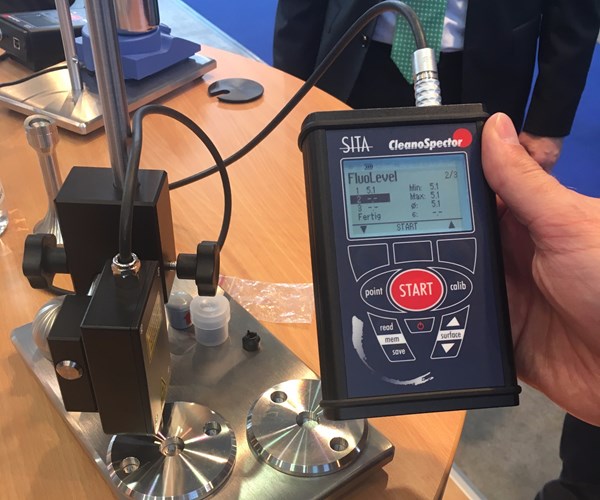Parts2clean Reveals Parts Cleaning Market Trends
A first visit to parts2clean in Stuttgart, Germany, is eye-opening to the importance of the parts cleaning market.

The SITA CleanoSpector inspects surface cleanliness. The fluorescence measuring principle allows detection of slightest traces of contamination such as oils, grease or cooling agents. It can also measure the layer thickness of oils, anticorrosive agents or bonding agents.
My first visit to parts2clean in Stuttgart, Germany, this week opened my eyes to the importance of the parts cleaning market. Although the topic of parts cleaning gains more interest in Germany because of the more stringent cleanliness regulations in the European Union than in the U.S., I’ve learned from attending this year that these requirements are predicted to come overseas to the U.S. in the next five to ten years. Therefore, the U.S. parts cleaning market will gradually grow because the demand for this equipment will increase out of necessity.
Held at Stuttgart Messe, from Oct. 24-26, the show covers two halls. This 15th annual parts2clean is the largest yet, showcasing 253 exhibitors in 7,300 square meters of space. The show is easy to navigate and well attended--parts cleaning is a hot topic here in Europe.
Several cleaning experts I spoke with at the show mentioned that the automotive industry is one of the main drivers behind this demand for parts cleanliness. They said new types of materials used in auto manufacturing are demanding precision cleanliness. Also, research has discovered that parts that haven’t been precision cleaned can cause problems that are costly for auto manufacturers and can be dangerous for the end user.
Not only were there solutions displayed at the show for cleaning, degreasing, demagnetizing, bath care, corrosion protection and the handling and packaging of cleaned workpieces, but cleanliness control, analysis and monitoring equipment were also showcased in a big way. In fact, the displays on the show floor reflected this trend in quality control. Sensors, monitors and cleaning analysis equipment were prevalent throughout the show and popular among attendees.
When I asked exhibitors specifically about U.S. trends in parts cleaning, I was told that the U.S., as well as most other countries, are becoming more interested in global investments in parts cleaning equipment and are more open to exporting their equipment to other companies than ever before.
The industry is growing, and it’s important for U.S. machine shops to understand and embrace what’s in the near future for cleaning the parts they produce.
RELATED CONTENT
-
Heat’s Impact on Parts Cleaning
Thermal dynamics is important for assisting in the cleaning of a part. Adding heat or energy influences the cleaning process through its impact on chemistry, the water within the washer and its effect on drying.
-
The Best Technical Cleanliness Practices for ISO 16232
The aim is to assess and compare the technical cleanliness of parts produced by different manufacturers or at different locations.
-
Get to Know Cleanliness Standards
With a small amount of practice, it is possible to understand the underlying motivation of a cleaning standard and to figure out the specific aspects of the specification that are applicable to the customer.



